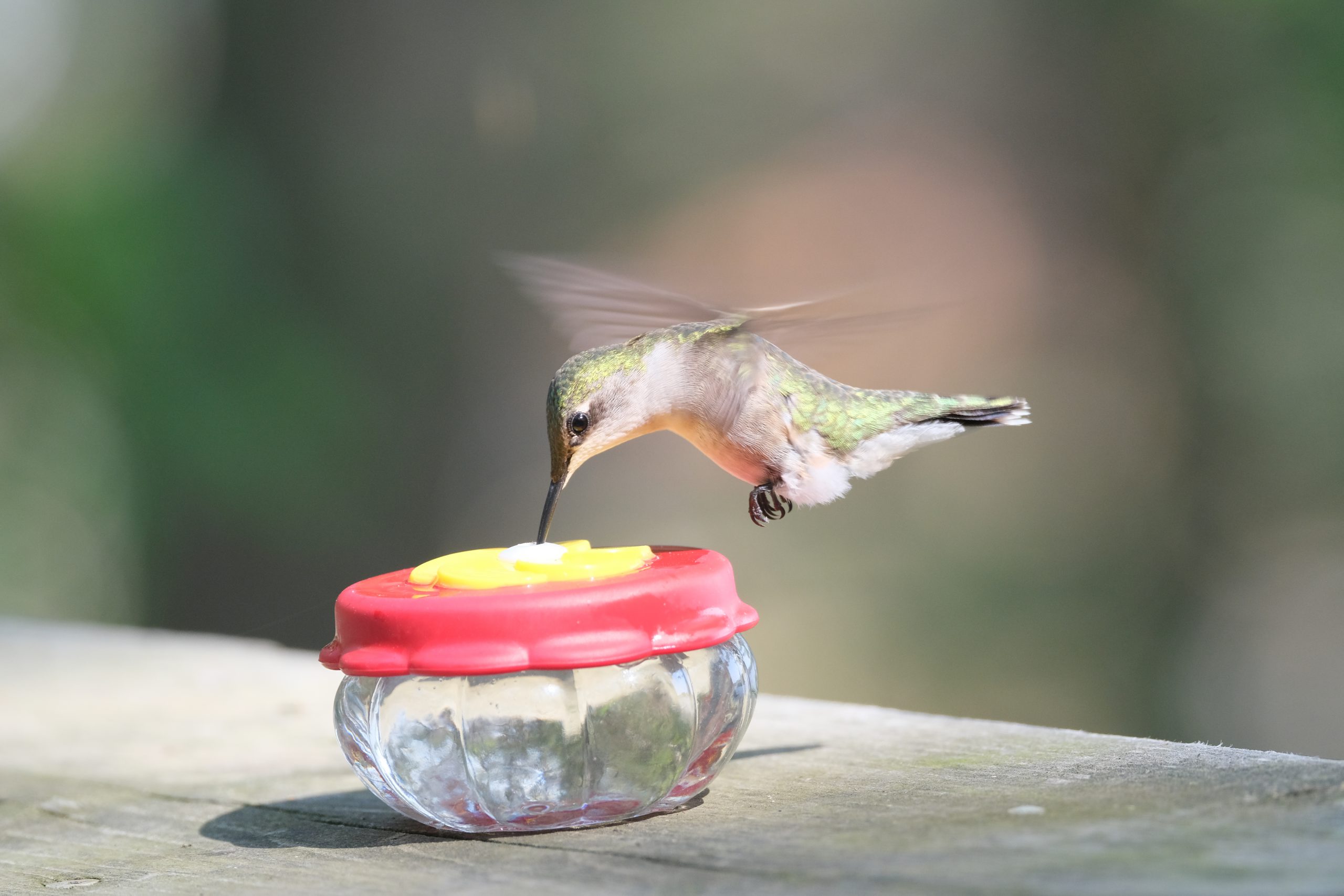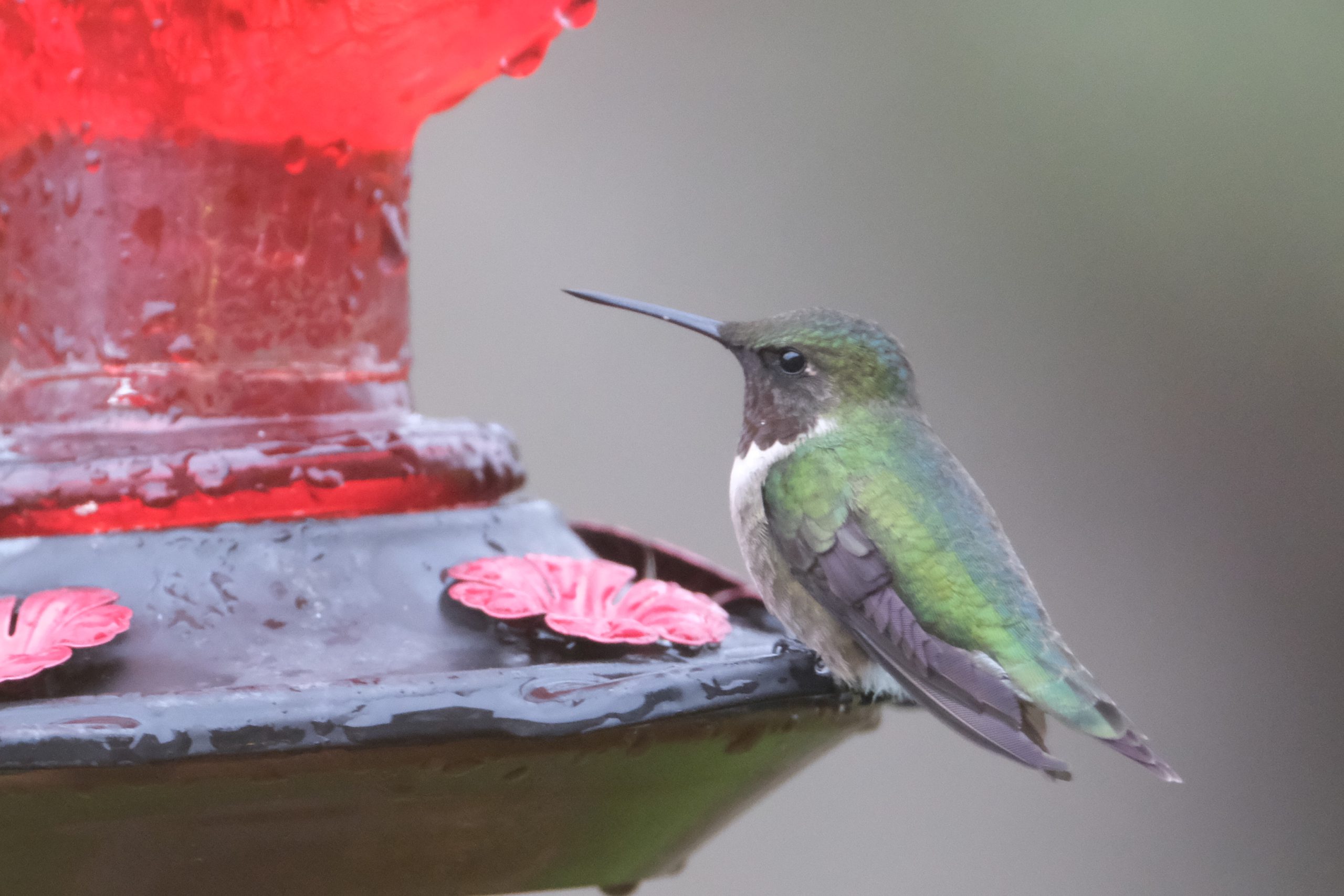By Kerrie Wilcox, Project FeederWatch Manager, Birds Canada
Hummingbirds are fascinating to watch and are so different from other birds attracted to feeders. Not only do they drink sugar water and ignore seeds, but everything from their tongue construction to their flight mode is uniquely adapted for feeding on nectar. While native flowers are the best source of nectar, a sugar water feeder can help supplement their diet and during migration may give them a needed energy boost to help them along their journey.
Follow these simple steps for attracting and feeding hummingbirds while creating a safer environment for them:
1. Choose a hummingbird feeder:
Make sure it is easy to open and clean, and has red parts. Flowers pollinated by hummingbirds are often red, and hummingbirds are attracted to that colour. (If your feeder does not have red on it, you can paint the glass with some red nail polish or tie a red ribbon on it). Glass feeders are recommended because soft plastic can break down in the heat.
The port size is important. If your ports are too small, they will not allow the nectar out and will be difficult for hummingbirds to use. Ports that are too large may leak and allow insects to get in. Consider adding bee guards, which snap over ports.
2. Make your own nectar:
Use this easy recipe: 1 part granulated white sugar to 4 parts non-distilled drinking water. Heat the water if necessary to dissolve the sugar. There is no need to boil safe drinking water.
Do not use honey. Honey fosters bacterial and fungal growth and ferments faster than sugar water, so it should never be used in hummingbird feeders.
Do not use red dye. The effects of red dye have not been studied in hummingbirds and may be harmful.
3. Change your sugar water regularly:
Scrub feeders with hot water and a clean bottle brush and refill every three days – and more often if it’s hot out. If you see any sign of cloudy water or mold, discard and clean immediately. Always rinse feeders in hot or boiling water before adding fresh sugar water. At least once a month, and immediately if you see black mold, soak your feeder in a mild vinegar solution for an hour and scrub with a clean bottle brush, then thoroughly rinse and dry.
4. Attract hummingbirds to your backyard:
Plant native plants to attract hummingbirds and provide natural food. Specific flowering plants are attractive to hummingbirds as a nectar source. Not only that, a diverse native plant garden will also benefit hummingbirds by supporting native species of insects and spiders. Though sometimes overlooked, insects and spiders form another important part of the hummingbird diet. Visit https://birdgardens.ca/ to learn which plant species grow well in your area and to find local nurseries that supply them.
5. Select the best placement:
Hummingbirds prefer feeders near trees and shrubs where they can rest and observe their surroundings. Set feeders in the coolest of areas, protected from the wind. Make sure your feeder is safe from cats and other predators.
6. When to put up and take down feeders:
Set up and fill your hummingbird feeder before the first spring hummingbird arrives. Male hummingbirds arrive a few days before females and young birds to scout out an area. Try to put out your feeders at least a week or two before hummingbirds are expected to arrive. (To estimate the arrival date, consult the Bar Charts on eBird.ca. Select your province or territory and county. Scroll down or, if you’re on a computer, search for “hummingbird” using the control+f or command+f function to see when hummingbirds arrive in your area). In the fall, you can help late migrants by waiting until you haven’t seen a hummingbird for three weeks before taking feeders down.

Ruby-throated Hummingbird, young male Photo: Kerrie Wilcox

Anna’s Hummingbird male Photo: Robert Hechler
Fun facts about feeding hummingbirds
If hummingbirds use your feeders all day long, they are probably residents, but if you see them only in early morning and late afternoon, they are probably migrating, because migrating takes place in midday. Over a period of about a month, a series of migrants may use your feeders without your realizing they are different individuals.
Hummingbirds have an amazing ability to remember locations of food sources. Spring migrants often astonish feeder owners by hovering expectantly over the spots where flowers or feeders were the previous year.

Ruby-throated Hummingbird female Photo: Kerrie Wilcox

